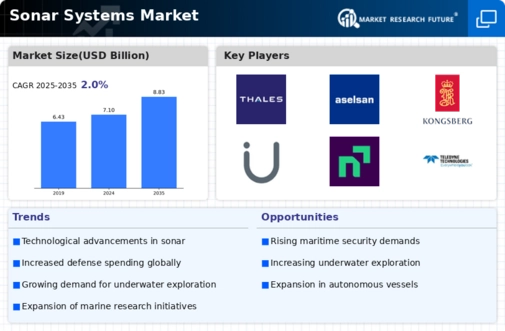Top Industry Leaders in the Sonar Systems Market

Key Players
Thales (France)
Aselsan (Turkey)
Kongsberg Gruppen (Norway)
Ultra Electronics (UK)
Navico (Norway)
EdgeTech (US)
L3 (US)
DSIT (Israel)
Teledyne (US)
Japan Radio (JRC) Co. Ltd. (Japan)
Sonardyne (UK)
Furuno (Japan)
Atlas Elektronik (Germany)
Strategies Adopted
Surviving and thriving in the sonar systems market necessitates the deployment of multifaceted strategies. Technological innovation is at the forefront, with companies investing heavily in research and development to enhance sonar capabilities. Raytheon Technologies, for example, continuously pushes the boundaries with advancements in acoustic and signal processing technologies, ensuring its products remain at the forefront of underwater detection.
Strategic collaborations are another prominent approach. Companies often form partnerships with defense agencies, research institutions, and other industry players to combine expertise and resources. Thales Group, through collaborations with navies and research organizations, reinforces its position as a global leader in sonar systems. Additionally, a focus on diversification, offering a range of sonar solutions catering to different applications, is a common strategy to address varied market needs.
Factors for Market Share Analysis
Several factors influence the analysis of market share within the sonar systems sector. Technological prowess and innovation play a pivotal role, with companies that consistently introduce state-of-the-art solutions garnering a larger market share. The ability to offer integrated systems, combining sonar capabilities with complementary technologies such as artificial intelligence and data analytics, is another critical factor. This ensures that sonar systems are not standalone, but part of comprehensive solutions that meet the evolving needs of defense and commercial clients.
Global reach and strong customer relationships contribute significantly to market share. Companies that establish themselves as reliable partners with navies, maritime agencies, and research institutions secure long-term contracts, fostering stability and market dominance. Additionally, factors such as product reliability, performance in challenging environments, and adherence to international standards for underwater systems further influence market share dynamics.
New and Emerging Companies
While established players dominate the sonar systems market, the emergence of new and innovative companies injects vitality and competition. Start-ups such as Aquabotix and OceanAlpha are making waves with their focus on autonomous underwater vehicles equipped with advanced sonar capabilities. These companies often bring agility and niche expertise, challenging traditional norms and driving innovation in the industry.
Moreover, the rise of companies specializing in environmental monitoring using sonar technology reflects a broader trend. As concerns about ocean health and climate change intensify, there is a growing demand for sonar systems that contribute to ecological research and environmental protection. These emerging companies cater to this niche, expanding the applications of sonar technology beyond traditional defense uses.
Industry News
Keeping abreast of industry news is crucial in understanding the pulse of the sonar systems market. Recent developments include the integration of artificial intelligence and machine learning algorithms into sonar data analysis, enhancing the accuracy and efficiency of underwater detection. Furthermore, the market has witnessed increased collaboration between sonar system manufacturers and marine research institutions to address challenges such as marine pollution, biodiversity monitoring, and climate change impacts on underwater ecosystems.
The geopolitical landscape also influences industry dynamics. Tensions in maritime regions prompt increased investments in naval capabilities, driving the demand for advanced sonar systems. Industry players must stay attuned to such geopolitical shifts to strategically position themselves in a market heavily influenced by defense budgets and national security priorities.
Current Company Investment Trends
Investment trends within the sonar systems market reflect the industry's response to evolving technological landscapes and emerging market demands. Companies are allocating resources to research and development initiatives that focus on miniaturization, increased detection range, and reduced power consumption. The pursuit of more compact and efficient sonar systems is driven by the need for integration into unmanned underwater vehicles and portable maritime platforms.
Sustainability is an emerging theme in investment trends, with companies exploring eco-friendly practices in manufacturing and disposal of sonar equipment. The responsible use of materials and adherence to environmental regulations are becoming integral aspects of corporate strategies, aligning with broader global sustainability goals.
Overall Competitive Scenario
The competitive landscape of the sonar systems market is characterized by a delicate balance between established industry leaders and innovative newcomers. Key players such as Raytheon Technologies and Thales Group set the technological benchmarks, while emerging companies bring fresh perspectives and applications. Strategies encompass technological innovation, strategic collaborations, and diversification to cater to diverse market needs.
Market share analysis factors include technological prowess, global reach, and customer relationships. The integration of sonar technology into environmental monitoring reflects a broader trend towards ecological awareness. Industry news highlights the convergence of sonar technology with artificial intelligence and increasing collaborations with marine research institutions.
Current investment trends emphasize miniaturization, increased detection range, and sustainability. As the sonar systems market continues to evolve, companies that navigate these trends, embrace innovation, and address emerging environmental concerns will position themselves as leaders in this critical sector, ensuring that the depths of the ocean are explored and protected with both technological excellence and environmental responsibility.
Recent News
Thales Group (HO)
Secured a major contract with the French Navy to supply the Captor family of sonars for their new frigates, bolstering their position in the high-end military market.
Unveiled a new towed sonar system with advanced signal processing and artificial intelligence capabilities, aiming to detect and classify underwater threats more effectively.
Kongsberg Gruppen (KOG)
Launched a new compact and lightweight sonar system specifically designed for autonomous underwater vehicles (AUVs), expanding sonar applications to smaller unmanned platforms.
Signed a contract with a major offshore oil and gas company to provide sonar technology for underwater pipeline inspection, highlighting its role in commercial industries.
Lockheed Martin Corporation (LMT)
Developed a next-generation underwater acoustic communication system using laser technology, enabling reliable data transmission at longer ranges and deeper depths.
Partnered with an Australian research institute to explore the use of bio-inspired sonar designs for improved underwater performance and efficiency.


